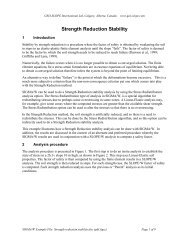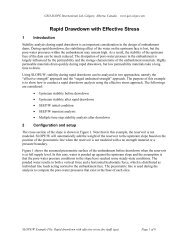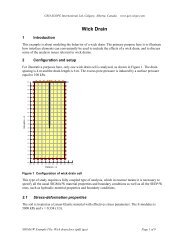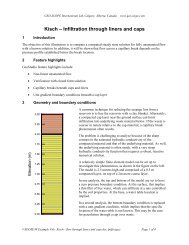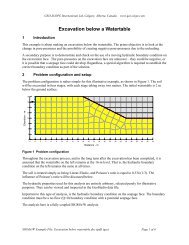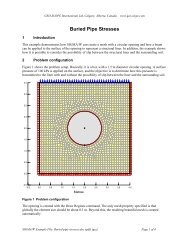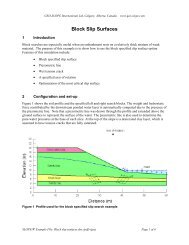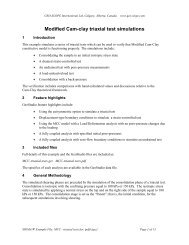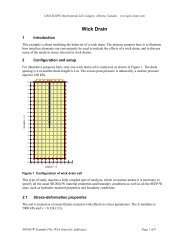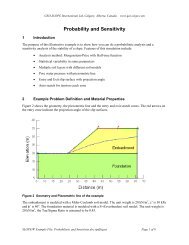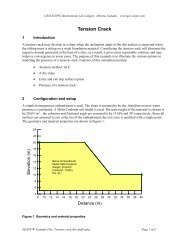Seepage Modeling with SEEP/W - GeoStudio 2007 version 7.22
Seepage Modeling with SEEP/W - GeoStudio 2007 version 7.22
Seepage Modeling with SEEP/W - GeoStudio 2007 version 7.22
Create successful ePaper yourself
Turn your PDF publications into a flip-book with our unique Google optimized e-Paper software.
Chapter 2: Numerical <strong>Modeling</strong><br />
<strong>SEEP</strong>/W<br />
Quantitative predictions<br />
Most engineers, when asked why they want to do some modeling, will say that they want to make a<br />
prediction. They want to predict the seepage quantity, for example, or the time for a contaminant to travel<br />
from the source to a seepage discharge point, or the time required from first filling a reservoir until<br />
steady-state seepage conditions have been established in the embankment dam. The desire is to say<br />
something about future behavior or performance.<br />
Making quantitative predictions is a legitimate reason for doing modeling. Unfortunately, it is also the<br />
most difficult part of modeling, since quantitative values are often directly related to the material<br />
properties. The quantity of seepage, for example, is in large part controlled by the hydraulic conductivity<br />
and, as a result, changing the hydraulic conductivity by an order of magnitude will usually change the<br />
computed seepage quantity by an order of magnitude. The accuracy of quantitative prediction is directly<br />
related to the accuracy of the hydraulic conductivity specified. Unfortunately, for a heterogeneous profile,<br />
there is not a large amount of confidence about how precisely the hydraulic conductivity can be specified.<br />
Sometimes defining the hydraulic conductivity <strong>with</strong>in an order of magnitude is considered reasonable.<br />
The confidence you have defining the hydraulic conductivity depends on many factors, but the general<br />
difficulty of defining this soil parameter highlights the difficulty of undertaking modeling to make<br />
quantitative predictions.<br />
Carter et al. (2000) presented the results of a competition conducted by the German Society for<br />
Geotechnics. Packages of information were distributed to consulting engineers and university research<br />
groups. The participants were asked to predict the lateral deflection of a tie-back shoring wall for a deep<br />
excavation in Berlin. During construction, the actual deflection was measured <strong>with</strong> inclinometers. Later<br />
the predictions were compared <strong>with</strong> the actual measurements. Figure 2-5 shows the best eleven submitted<br />
predictions. Other predictions were submitted, but were considered unreasonable and consequently not<br />
included in the summary.<br />
There are two heavy dark lines superimposed on Figure 2-5. The dashed line on the right represents the<br />
inclinometer measurements uncorrected for any possible base movement. It is likely the base of the<br />
inclinometer moved together <strong>with</strong> the base of the wall. Assuming the inclinometer base moved about<br />
10 mm, the solid heavy line in Figure 2-5 has been shifted to reflect the inclinometer base movement.<br />
At first glance one might quickly conclude that the agreement between prediction and actual lateral<br />
movement is very poor, especially since there appears to be a wide scatter in the predictions. This<br />
exercise might be considered as an example of our inability to make accurate quantitative predictions.<br />
However, a closer look at the results reveals a picture that is not so bleak. The depth of the excavation is<br />
32 m. The maximum predicted lateral movement is just over 50 mm or 5 cm. This is an extremely small<br />
amount of movement over the length of the wall – certainly not big enough to be visually noticeable.<br />
Furthermore, the actual measurements, when corrected for base movement fall more or less in the middle<br />
of the predictions. Most important to consider are the trends presented by many of the predicted results.<br />
Many of them predict a deflected shape similar to the actual measurements. In other words, the<br />
predictions simulated the correct relative response of the wall.<br />
Consequently, we can argue that our ability to make accurate predictions is poor, but we can also argue<br />
that the predictions are amazingly good. The predictions fall on either side of the measurements and the<br />
deflected shapes are correct. In the end, the modeling provided a correct understanding of the wall<br />
behavior, which is more than enough justification for doing the modeling, and may be the greatest benefit<br />
of numerical modeling, as we will see in more detail later.<br />
Page 8



